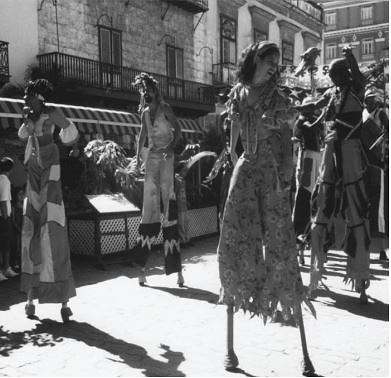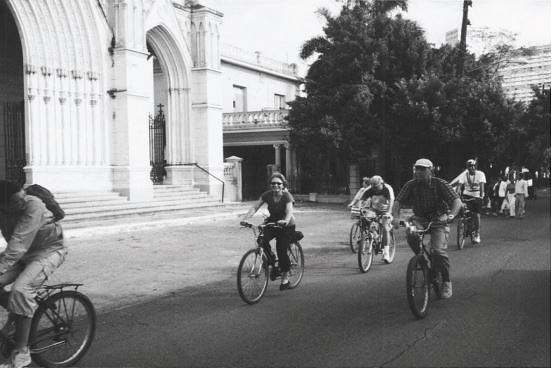
January 2003 Going to Cuba was a bit of an adventure, since I could not fly there directly from the United States. I went via Nassau and met up with my son Selim in Havana. Upon arrival at the airport, I quickly realized that patience is a great virtue on this island. It took an hour and a half to clear passport control and an hour in the hotel lobby to obtain a room assignment.
Old Havana is a grand city in decay. Its main boulevard, the Paseo, has a pedestrian mall at the center, with magnificent colonial buildings on either side. European governments have restored some, but many others have turned into slum housing. The laundry lines on so many of the balconies and rooftops and in alleyways struck me as a common image throughout the city.
Cubans are neat and clean, despite the scarcity of goods and water. They have ration cards for food, which allows them to meet their monthly basic needs — such as beans, rice, vegetables, bread, and milk — at fixed prices. Those who have access to dollars can buy additional foods, including meat, at the open air market. A ration system is the government’s way of ensuring that everyone has a basic level of sustenance.
People ride public buses, called camellos (camels), which are 18-wheel converted trucks, or stand in the streets to wave down any vehicle willing to pick them up. Waving a dollar bill expedites the pick-up. The most common mode of transportation is the bicycle, a Chinese import. Old cars are a major tourist attraction. Antique Buicks, Cadillacs, and classic Chevys offer city tours. Selim and I toured both New and Old Havana by bicycle and car, stopping at civic plazas, parks, and national monuments along the way. A sculpture of John Lennon sitting on a park bench and a statue of Don Quixote riding his horse in a public square brought smiles. Slogans on billboards and walls took the place of commercial advertising. Other places we visited included the produce and meat markets, the university, the Colón Cemetery, and the Afro-Cuban neighborhood, where the Santera religion is practiced.
Santera, a widely practiced religion, is an amalgam of Catholic and Yoruba beliefs. Catholic saints are associated with Yoruba deities or orishas. The concepts of original sin and final judgment are unknown; instead ancestral spirits are worshipped. The rites of Santera are controlled by a male priest called a babalawo, who is often consulted for advice, to cure sickness, or to grant protection; offerings are placed before a small shrine in his home. Real power is thought to rest in stones draped with colored bead necklaces. These stones are believed to harbor the spirits of the orishas; therefore, they are provided with food, herbs, and blood. Animals such as chickens, doves, and goats are sacrificed during rituals.

Vibrant street life in Havana
In Cuba, health care and education, including university, are totally subsidized by the government. Therefore, the literacy rate is very high. There are many bookstalls on the streets. However, the selection of books is ideologically limited. In spite of all the restrictions on the choice of goods, food, and housing, people display a great joy of life. They are quick to break into song and dance, and have a vibrant street life. Women having their hair braided at sidewalk beauty stands and young girls in red gowns, which celebrate puberty, enliven the local color.
Our Cuban tour included Cienfuegos, known as the “pearl of the south,” on a bay that opens into the Caribbean Sea. This colonial city stood out with its neoclassical architecture, well laid out streets, and lively musical tradition. Continuing south on the coastal road to Trinidad, we stopped by a village known for its hand-embroidered goods. White linen billowing in the wind, along with blouses and vests, hung from clothes lines as far as the eye could see to catch attention; I bought a vest off the line.
Trinidad, a coastal colonial city designated a world heritage site by UNESCO in 1988, sits near a valley of sugar cane mills, where we learned about processing sugar. Selim operated a mill by hand to extract cane juice, which we collected for drinking. Riding in an open truck on poor mountain roads, we admired the luscious countryside, went to an underground cave, and visited a tobacco farm and a factory, where dried leaves were hand-rolled into cigars. Walking around the city was a trip back in time, as its baroque church towers, Carara marble floors, wrought iron grills, red tile roofs, and cobblestone streets have changed little in a century and a half.
Our trip culminated in the lovely resort town of Varadero, which features many luxury hotels. These hotels are only for tourists. Cuban people do not enjoy them, nor are they allowed to eat in any of the bountiful restaurants. We welcomed the two days of luxury by the Atlantic Ocean. The beaches were wonderful. On my return trip, I had to wait over an hour to obtain my boarding pass at Havana airport. The computers were down due to a power outage. When I arrived in North Carolina to catch my connecting flight to Boston, it felt good to find a restroom with running water. A country of picturesque towns, beautiful landscapes, and a fascinating culture, Cuba appeared unraveled in its present state, leaving me with a yearning to return in 10 years’ time.

Bike tour of Havana
